I have a confession to make: I’ve never been that into birds—well, at least until recently.
When I was seven-years-old, I was on a field trip at the Great Salt Lake in Utah. I don’t remember much besides the insane number of bugs crashing into my skin, which was sticky with sweat and salt, and the feeling of bird droppings dripping down my forehead as an entire class of second graders pointed and laughed.
This place, these birds, were nightmarish things that I would continue to fear well into adulthood. So, when my coworker came to me a year ago with the idea to set up a kestrel nest cam at the Great Salt Lake, I’ll admit I was less than enthused.
But after all of the hard work to get the camera up and running, when the kestrels started visiting our nest box, something happened that I never expected. I became addicted to watching them, biting my nails anxiously to see if the male found his mate, and audibly cheering in my office when the nest footage revealed not one, but two eggs in the nest.
Bird cams, it turns out, are a lot of fun, and kestrels in particular are fiercely cute and fascinating.
Enthusiasm is Contagious
As my colleagues and I waited to see if the female kestrel would return to nest after laying her first egg, we discussed all the things we love about these birds. Some things we had never noticed before, like the face-like markings on the backs of their heads. Other things they had thought for a while, but their fond memories resurfaced as we watched this kestrel family grow. Their love of birds was starting to rub off on me.
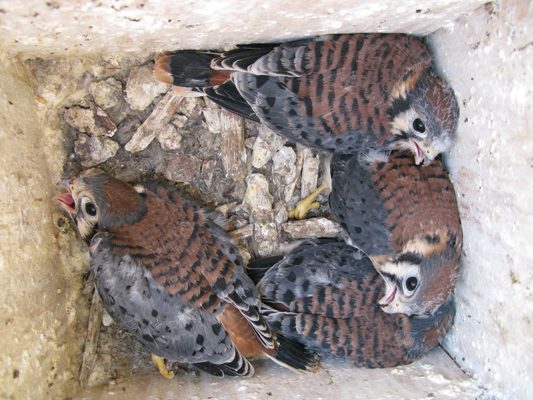
Andrea Nelson, who had suggested we create a kestrel cam in the first place, particularly inspired me. “I look at birds of the Great Salt Lake as a tapestry,” she said. “We have more than 300 species of birds at the Great Salt Lake at different times of the year, migrating in and migrating out. The kestrels are just one little part of this beautiful tapestry.”
Not Your Average Wetland Bird
The truth is, when we think of Great Salt Lake birds, we often think of waterfowl, long-legged shore birds, birds that are feeding on brine shrimp and brine flies, and even birds that are feeding on the fish. But surrounding this huge and wonderful lake is all of this open land. Grasslands and wetlands stretch across this unique landscape, and it is here where upland birds find their habitat.
In these ecological niches, voles, mice, and rodents can be feasted upon by predatory birds. If left unchecked, too many rodents could decimate the native plant populations, which is why birds of prey are such a welcome sight at the Great Salt Lake Shorelands Preserve.
Standing from the boardwalk, you will see majestic hawks swoop down and catch their prey. And then, in the distance, a small American kestrel hovering above the grass, with the same great ferocity, will also make its kill. This is the delightful dance of species that make up the mosaic of the Great Salt Lake ecosystem.
“These cute, little, charismatic miniature falcons are killing machines,” Andrea laughs, “with super sharp talons and cool hooked beaks that are important to the greater ecosystem. They are filling this particular niche and keeping the rodent population under control.”
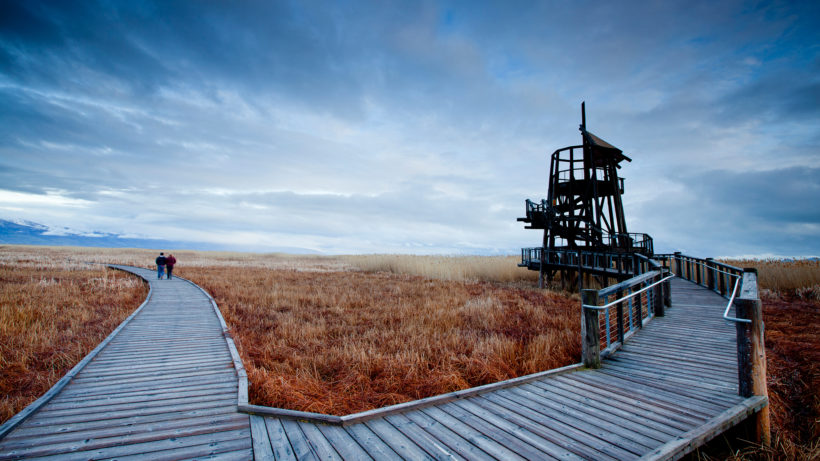
Common, But Not Unthreatened
It’s easy to laugh when you see kestrels and realize they’re such a powerful little package, but the reality is, these birds still need our protection.
Although kestrels are widespread across North America, they are losing their habitat to development like so many other birds at the Great Salt Lake. This area is a critical stopover in the West for migratory birds, which need lots of space to nest and feed during their visits. However, the cities nearby are expanding rapidly as the population in Utah booms, pushing new homes closer and closer to these important wetlands.
“I see these birds as ambassadors of this area,” Andrea continues. “They are a reminder that these birds are our neighbors, and we need to take care of them.”
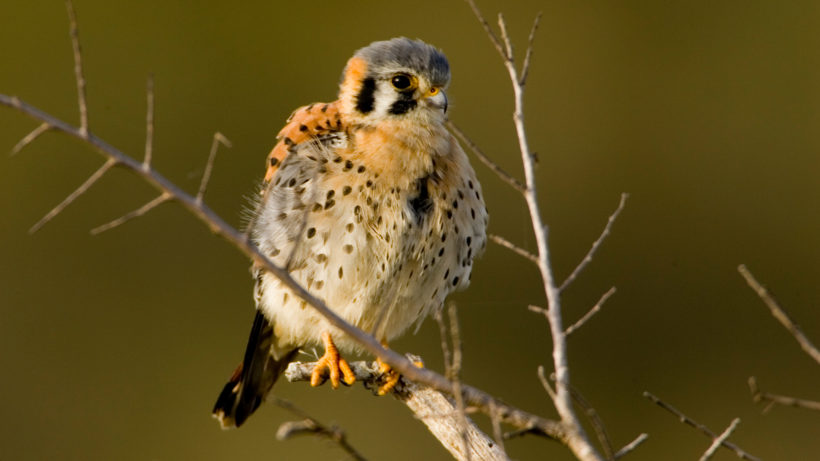
As I sit and watch the kestrel nest, my nose inches from my computer screen, I’m letting go of my old fears. I learn something new about these birds every day, and I can’t help but care about what happens to them.
Like a worried parent, I grow anxious when the kestrels disappear from the nest for too long. But when the mama kestrel returns to her eggs once more, I let out a great sigh of relief. Maybe these kestrels will be okay after all. Maybe if people see what I see, they’ll want to protect them too, so we can be fortunate enough to observe them again next year, and the year after that.
I may be a budding birder yet.
UPDATE: Tune in to the 2023 nest cam in May and June!
This nestbox is one of 25 on TNC lands along the Great Salt Lake Shoreline. We partner with HawkWatch International, whose army of citizen scientists monitor these boxes along with 400+ others in Northern Utah each spring, and have done so since 2013 as part of an American Kestrel Partnership project.
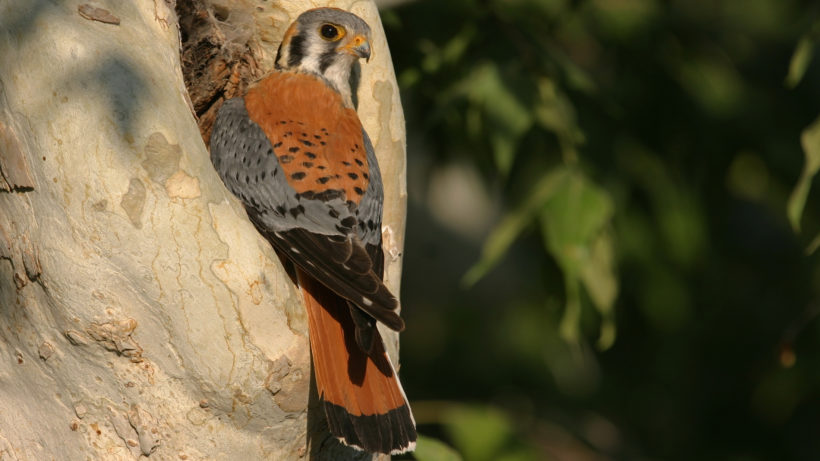
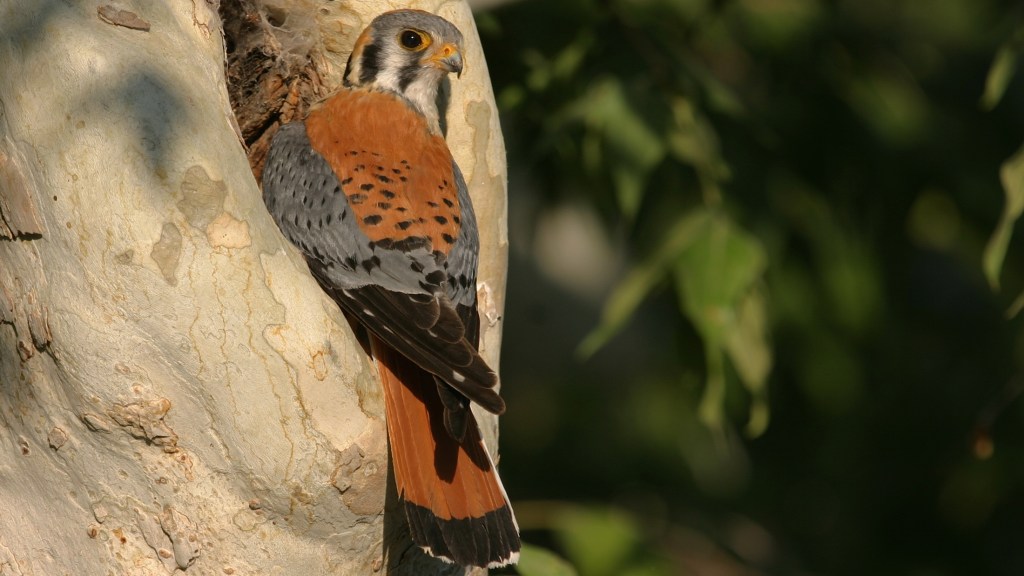



Is the small kestrel dying? The mother never seems to feed it
Hi Betty, Thank you for your question! We were not sure what would happen with this chick. The mother did feed it – though less often than the older siblings. This is common for birds, to ensure that at least some of the chicks survive, the parents favor larger stronger chicks at feeding time. When food is plentiful, all of the chicks get enough to survive, but when food is scarce, some chicks don’t make it. It looks like this was a year of plentiful food and the chick has fledged. As of June 6, 2018, all five kestrels have left the nest. They are now off spreading their wings and hunting at the Great Salt Lake. Thank you for joining us during the debut season of our kestrel cam. We hope you’ll join us again next year!
I notice that one little guy is aware of the cam. He keeps looking up at it while the others just huddle together. That’s the Rhodes Scholar of the chicks. He’ll go far.
Kestrels are beautiful Birds!
Information on bluebird habits ?
Hi Helen, Thank you for your question! Matt Pelikan says “About bluebirds, the preferred nesting habitat is semi-open habitat, often field edges. They seem to like having plenty of perches around – a typical feeding strategy is to sit in a pole or snag and then pounce on insects that show themselves – and of course the presence of suitable nesting boxes or natural cavities is a requirement, since bluebirds are cavity nesters. Their preference for semi-open settings and edges often brings bluebirds into agricultural landscapes, a human-created version of the habitat that works best for bluebirds.” He recommends http://www.sialis.org/ as a good place to learn more. There are three species of bluebirds in the US (Eastern, Mountain, and Western) Sialis has information on all three.
Just wondering, hs anyone seen the adult feed either of the two least aggressive chicks that appear for the moment to be in the lower right corner of the cam picture? I understand people’s concerns, but must also say this seems like a large brood – six chicks! Is this typical, and then, how many typically survive to fledge from a group this size?
I am thrilled to see this cam-action, and will be checking back. Thanks to all who are making this possible.
I live right on the Hudson, and have loved watching the return of the raptors to the corridor.
Hi Shelly, Thank you! The parents have been feeding the less aggressive chicks as well – not at every feeding, but enough to keep them going. Regarding the size of kestrel clutches, our ecologist and birder Matt Pelikan says: “Great question! Yes, six is a large clutch, though not unprecedented; four is normal, and the largest I’ve found records of is seven. And yes, the more active chicks are likely to get fed first and most often, to the detriment of the less active ones. (Interestingly, there is some evidence of sex-based behavioral differences in kestrel chicks, with females tending to be more aggressive. This might be an evolutionary strategy to ensure that egg-laying capacity is maintained in a population even when resources are scarce.)
I don’t know what governs clutch size in kestrels. One plausible hypothesis is that the female’s diet while she’s laying plays a role, perhaps with more food and protein resulting in more eggs (which take a lot of the body’s resources to produce).
If food is plentiful, it’s certainly possible that all six will survive to fledging. But it’s pretty usual with raptors that one or more chicks in a clutch, usually the smallest, weakest ones, don’t survive. My guess – it’s just a guess – is that four will eventually make it out of the nest.”
PS I’ve been counting five chicks in this clutch, but it is hard to count when they are sitting in a cluster, so my count could be off. Thank you!
I know it’s the way of nature but I just cannot watch a mother bird come into the nest and end of feeding all the food to the aggressive one, and then some to the next aggressive one, while the other 3 don’t get anything. It makes me too sad and I will not watch again.
Hi, I love your kestrel nest cam!! I live in Illinois & rarely (if ever) do we get to see kestrels in the wild. By my count there are 5 chicks in this nest. This seems like a lot, is this a normal brood? Hopefully they all make it out of the nest, grown & healthy! Thank you for helping the rest of us be able to peek in on their lives, if just for a short time. God bless!
Hi Theresa, Thank you for the question! We had another question about clutch size and feeding behavior below from Shelley Stern and I’ve posted a more complete response there. Our ecologist Matt Pelikan says that 4 is an average clutch size and the largest reported in the literature is seven.
Unsupported video type or invalid file path appeared on the cam video screen. I really can’t seem to get round the block, not sure others have same problem. Then the miracle happened I looked out the window as I was just typing this and a Western Tanager settled on a branch opposite the window what a treat. Len
Hi Len, Could you let me know what browser and operating system you are using so I can check with our developers and see if they can fix the problem? You might also try refreshing the browser, it’s not a perfect solution, but sometimes it works! Thank you for letting us know about this!
My wife and I had a nest box in Bellingham, WA and over a period of 5 years we raised 22 baby kestrels. The year we left there, our original pair didn’t return. However a new pair arrived and to my knowledge the new owner still maintains the nest box and the kestrels still return each year. They are fascinating birds to watch and they entertained us for countless hours in those 5 years. They are by far our favorite birds.
Everyone should check out the live web cam of the Peregrine Falcon living on top of the University of Texas Tower in Austin.
https://biodiversity.utexas.edu/resources/falcon-cam
Never mind.
It moved!
Is the nestling in the lower left corner dead? I’ve been watching for several minutes and haven’t seen it move or respond to its siblings.
Hi Nima, Thank you for asking! I saw it move just now, so it’s definitely alive. They’re sometimes very still when asleep. I can check with our scientist, Matt Pelikan to see if there’s a rule of thumb on how long chicks tend to stay still.
Matt Pelikan says “Sitting still serves multiple purposes for a baby bird: it conserves energy (important especially if food is scarce), and it helps prevent them from overheating if that’s an issue (the more active they are, the more heat their bodies generate). Also, sitting still keeps them quiet may help avoid attracting predators. You might say that sitting still is their “default setting” – it really doesn’t make sense for them to move much unless there is a reason. So how long they sit still for will depend on how much they’re getting fed, what the temperature is, and what they’re hearing outside the nest box.
Everything changes, of course, when an adult shows up with food. Then the goal is to be as noisy and active as possible, to attract the adult’s attention. But you can expect there to be very little activity in the box in between feeding visits; the chicks have no reason to move and a bunch of reasons to keep still.”
Thank you for this beautiful posts! I never really knew about kestrels before now!
Ann
Thank you Ann! We hope you enjoy watching the cam and learning more!
I enjoyed the beautiful photos and had new insights into the facial markings on its head. In a dark nest cavity a potential predator might be quite startled to see “large moving eyes”, and thus deterred from further exploration. I am a retired ornithologist and have always wondered about these markings on the back of the kestrel’s head. I think your excellent photos may help solve the problem.
In the 1960’s my fiancee and neighbor used to collect birds of prey for Morley Nelson, a falconery and photographer. I sewed the jesses and hoods that they used after the birds were captured. At one time I had a male sparrowhawk (American Kestrel) trained to the hand. What an incredible lifetime experience.